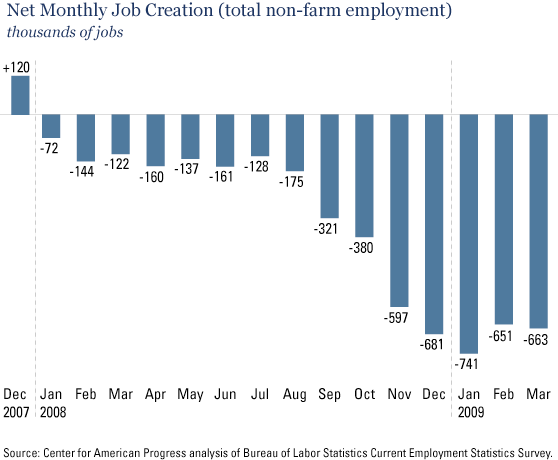|
APRIL 2009 UNEMPLOYMENT DATA*
(U.S.
BUREAU OF LABOR STATISTICS)
OFFICIAL UNEMPLOYMENT:
8.9%
A year earlier, the number of unemployed
persons was 7.7
million, and the jobless rate was 5.0 percent. [BLS]
| White |
8.0% |
| African
American |
15.0% |
| Hispanic |
11.3% |
| Asian** |
6.6% |
| Persons with a disability** |
12.9% |
| Men
20 years and over |
9.4% |
| Women
20 years and over |
7.1% |
| Teen-agers
(16-19 years) |
21.5% |
| Black
teens |
34.7% |
| Officially
unemployed |
13.7
million |
HIDDEN UNEMPLOYMENT
| Working
part-time because can't find a full-time job: |
8.9
million |
| People
who want jobs but are
not looking so are
not counted in official statistics (of which about 2.1 million**
searched for work during the prior 12 months and were available
for work during the reference week.) |
5.9
million |
|
Total:
28.5 million (17.7% of the labor
force) |
Source: http://www.bls.gov/news.release/pdf/empsit.pdf
In addition, millions
more were working full-time, year-round, yet earned
less than the official poverty level for a family of four. In
2007, the latest
year available, that number was 17.6 million, 16.2 percent of
full-time workers (estimated from Current Population Survey, Bur.
of the Census, 2008).
In
March, 2009, the latest month available, the number of job
openings was only 2.7 million, according to the BLS,
Job Openings and
Labor Turnover Estimates, May 12, 2009.+ Thus there
are more than 10 job-wanters for each available job.[Numbers
are not comparable with previous months as methods have been revised.]
Mass
layoffs: "Employers
initiated 3,489 mass layoff events in the first quarter of 2009
that resulted in the separation of 558,909 workers from their
jobs for at least 31 days, according to preliminary figures released
by the U.S. Department of Labor's Bureau of Labor Statistics.
Both the number of extended mass layoff events and associated
separations reached their highest first quarter levels in program
history (with data available back to 1996), and both measures
more than doubled from the first quarter of 2008. The number of
separations reached first quarter program highs in 12 of 18 major
industry sectors, all 4 geographic regions, and 32 states. Separations
due to business demand reasons (especially slack work/insufficient
demand) set a program high, while those associated with financial
issues reached a high for the first quarter. Each category
more than tripled over the year. Twenty-seven percent of employers
reporting an
extended layoff in the first quarter of 2009 indicated they anticipated
some recall of workers, the lowest proportion in program history.
First quarter 2009 layoff data are preliminary and are subject
to revision." (BLS, May 12, 2009)
*See Uncommon
Sense #4 for an explanation of
the unemployment measures.
**Not seasonally adjusted.
+"The number of job openings has trended downward since mid-
2007, and, at 2.7 million in March, monthly openings were down
2.1 million, or 44 percent, since the most recent high point in
June 2007. The decline in the job openings rate at the total nonfarm
and total private levels was due to small, nonsignificant declines
in nearly every industry and a significant decline in retail trade.
....Over the 12 months ending in March, the job openings rate
(not seasonally adjusted) fell significantly in nearly every industry
and in three of the four regions. The rate did not change significantly
in the Northeast region and in construction; information; other
services; and federal government."
 Source:
http://www.americanprogress.org/issues/2009/04/no_good_news.html Source:
http://www.americanprogress.org/issues/2009/04/no_good_news.html
The
National Jobs for All Coalition is a project of the Council on
Public and International Affairs. |

